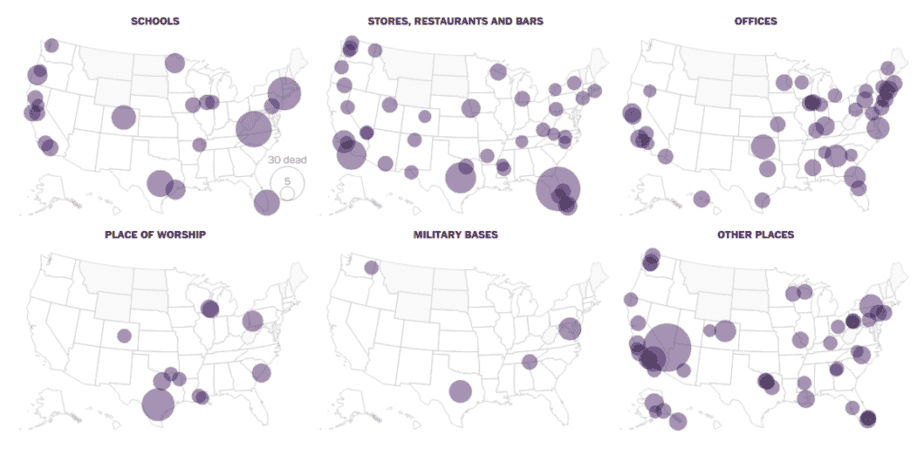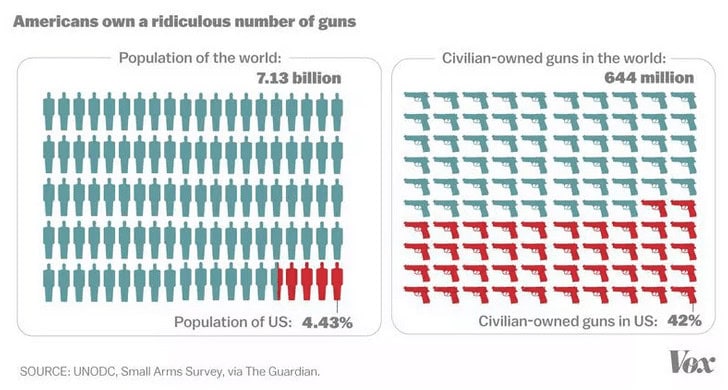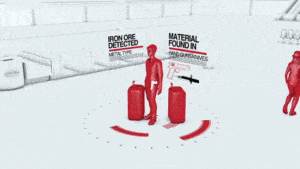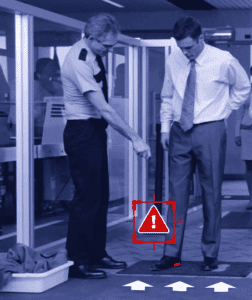
The headlines of mass shooting incidents just don’t stop. Where do we draw the line and say enough is enough? My heart hurts to keep reading these headlines. It feels like there is nothing that can be done to stop the bloodshed.
Politicians are unwilling or unable to make the necessary legislative actions to limit the accessibility of military type assault weapons for various reasons. There is a large portion of the US electorate that see any gun legislation as threatening their liberty and God-given right to own a gun.
Nobody wins and the bloodletting continues...
Let’s put it into perspective…
The people who were killed came from nearly every imaginable race, religion and socioeconomic background. Their ages range from the unborn to the elderly; 189 were children and teenagers. In addition, thousands of survivors were left with devastating injuries, shattered families and psychological scars.[1]
In the US, as of this writing, there have been at least 2,178 mass shootings since Sandy Hook, with at least 2,457 killed and 9,120 wounded.[2] In fact, just last month 34 people were killed and 188 injured. And here we are in the first week of August and already we have two two more tragic mass shootings, one in El Paso, Texas and the other in Dayton, Ohio. The month of August now tallies 36 killed and 78 injured.[3]
So many, that they often do not make headline news anymore.

As I have said before in my previous articles, with the help of emerging weapons detection technology, there is hope to curb these mass shootings in public spaces (concerts, nightclubs, transportation hubs, sporting events, shopping malls and schools).
We have all seen the metal detectors and body scanners at the airports. They are clumsy to use, only process one person at a time, are obtuse and frankly not wholly effective.[4]
Let’s put aside old school tech that doesn’t particularly work well. What is exciting right now is the complete revolution in weapons detection technologies that a few small public companies are taking from concept to development stage and to finally the commercial deployment stage.
The companies that I will show you are combining several different newly emerging technologies into innovative security solutions that scan crowds and identify concealed weapons hidden on the torso, in a bag or backpack, while adding to increased security for public spaces.
In addition to identifying potential active shooter threats, the systems perform their work "behind the scenes" or covertly, without slowing down the movement of people, with minimal intrusion to personal space, and could promise an unprecedented level of security.
Do I have your attention now? I thought so!
Let's take a closer look at the cutting-edge technologies being employed in the fight to keep our public spaces free of weapons that do not belong.
What we are seeing in the weapons detection space is a convergence of several cutting-edge technologies. All of these technologies are moving from the tech laboratory and eventually into our daily lives. While relatively new, the development of these technologies have only been around a few years.
I need to make a call-out here... Investors need to practice patience with this new sub-category of advanced security.
In short, these advancements are game changers in interpreting data and understanding the world around us. Artificial Intelligence (AI) can be loosely interpreted as incorporating human-like intelligence into machines / computers. This occurs whenever a machine completes tasks based on a set of stipulated rules that solve problems (algorithms), i.e. “intelligent” behavior. Those rules are written by a human and the program follows the rules for the desired outcome.
Basically, there are two sub levels of Artificial Intelligence: Machine Learning and Deep Learning.
Machine Learning (ML) enables machines to learn by themselves using the provided data and then make accurate predictions. The machine literally learns as it goes, rewriting the programs it follows to make those predictions.
Deep Learning (DL) is the next evolution of machine learning.
DL algorithms are roughly inspired by the human brain and how we process patterns. Just like we use our brains to identify patterns and classify various types of information, deep learning algorithms can be taught to accomplish the same tasks for machines.[5]
Learn more about investing in AI in my article here.

Radar technology has been in use for many decades.
The technology is relatively simple and already in use. You’ve seen them before at the supermarket or Walmart. It’s that little black box above the door that detects you are walking towards the door and opens it for you.
Or maybe you have a radar detector in your vehicle that detects upcoming police speed traps on the highway and sounds an alarm when police radar is detected that measures your advancing speed.
Those are simplified and may be considered primitive versions of the technology used by some of the weapons detection systems on the market today.
Current innovations in radar technology are pushing the envelope in what these radar waves can do. Micro, millimeter and hexawaves are becoming more refined in what they can "see" and the data they provide and transmit back to a receiver to create 3D images, and in this case a weapons signature, that can be further analyzed.
These nanoscale sensing devices measure physical quantities of a chemical or biological agent and convert that to a signal that can be detected and analyzed by these advanced systems. They are highly sensitive and operate at a similar scale as natural biological processes.
These sensors are already changing the way air and water quality are measured due to their size, quickness, and accuracy of measurements.[6]
Combined, each of these technologies create a synergistic effect where the sum is greater than its parts.
Each of the companies I am about to introduce to you are using these emerging technologies mentioned above and combining them in innovative ways to tackle the job of searching for concealed weapons in public spaces before they could do any harm.

While it is difficult to pick out one particular technology that is the most important advancement, if pressed I would have to say that companies incorporating Artificial Intelligence (AI) remain a standout today.
AI technology makes possible the scanning of data at speeds humans could never do. It pulls out comprehensive data that is often overlooked by its human counterpart. ML and DL continue to progress in their ability to rewrite their own algorithms and produce a deeper and more accurate understanding of data received that has never been seen before.
In the world of weapons detection, the data that wave transmitters and receivers, nanotech sensors and video camera feeds are producing are sent to AI to interpret. The results produced by AI algorithms are then classified according to threat levels and alerts are automatically sent to authorities to take appropriate action to neutralize any given situation where the technology is deployed.
Is the weapons detection space getting overcrowded? I think not. Both as an investor and a US citizen, I prefer to have whatever ultimately becomes the best technology to protect myself and my family against an active shooter threat.
Each of these three emerging growth companies below are working to become the first and/or best product offering to detect concealed weapons in public spaces that could stop an active shooter before turning into a dangerous situation.
Patriot One Technologies (TSX.V: PAT / OTCQX: PTOTF / FRA: 0PL)
Those of you who follow FNN, and my articles in particular, know that I am a huge fan of concealed weapons detection technology. My first article in the space was on Patriot One back in June of 2018. Those of you who took heed and did your research, witnessed some profit gains from Patriot One over the past year.

Patriot One has developed a three-prong weapons detection system.
The first piece of the threat detection puzzle Patriot One Technologies has developed is the PATSCAN™ CMR.
This is the unique radar detection technology I mentioned earlier. The technology is intended to be placed at key access points utilizing radio/radar wave emissions to safely target, identify and notify of concealed weapons threats sent through software recognition of specific wavelength patterns.
It is an automated alert system capable of covertly screening moving individuals for on-body concealed weapons including handguns, knives, grenades, explosive vests, etc.
PATSCAN VRS harnesses existing security camera infrastructure, and marries Patriot One’s proprietary Artificial Intelligence (AI) technology to visually scan for weapons, disturbances and suspicious behavior. The AI tech automatically scans images and alerts security personnel of any potential threats.
The third addition to their security suite is the PATSCAN STS. This technology offers a detection device that scans for and identifies potentially lethal airborne chemicals and explosives with a parts-per-billion sensitivity. Again, this technology is part of the AI system, and it alerts officials of combined possible threats to security personnel autonomously.
The latest technology they have added is the PATSCAN TMS. This system employs intelligent targeted magnetic sensor technology that can detect the on-body or in-bag location of a growing list of concealed threat objects, such as long barreled weapons and bombs.
Operationally, when two or more people pass between the concealed sensors at the same time, the TMS sensor components will identify which individual is carrying the threat object and where it is located on-body or in-bag.

The company just announced they have signed a collaboration agreement with Xtract Technologies Inc., a leading Canadian artificial intelligence company. Xtract will work closely with all of the PATSCAN platform component teams – CMR, STS, TMS and VRS – to explore how artificial intelligence technology can augment multiple data sets, such as people and threat objects, to enhance sensor threat-detection performance.
In addition, the Xtract team will examine ways data fusion between the sensor solutions can enhance overall platform effectiveness.[7]
Back in April, I wrote a follow up article on Patriot One highlighting the company's advances: their uplisting from the Junior TSX Venture Exchange to the Senior Toronto Stock Exchange (the big board “TSX”) in Canada, the subsequent attention from a major defense contractor, and, of course, its ever-increasing support from the investment community.
If you have not already read my two previous articles on Patriot One, I highly recommend taking the time to add these to your list of must-read articles when doing your research.
The company announced long term sales commitments with a potential CAD$8.1 million over an initial three-year period.[8]
Patriot One is still one of my personal favorites, and I have discovered two new up-and-comers in the sector that I think you will be interested in researching further…
Plymouth Rock Technologies Inc. (OTC: PLRTF/ CSE: PRT / FRA: 4XA)
Plymouth Rock touts they have over 100 years of combined experience and knowledge in the following disciplines:
In 2014, Plymouth Rock designed and delivered the world’s first affordable long-range suicide bomb and assault weapon detector.
Their current product lineup looks rather impressive.
MIRIAD (Millimeter Remote Imaging from Airborne Drone) is a compact RF (radio frequency) sensor package that is specifically designed for use on drones. The basic sensor format will be optimized to detect weaponry or suicide devices concealed on a person in an outdoor environment using passive millimeter wave radar.
For the record, I see a large future incorporating weapons detection technology into drones or UAV’s (unmanned aerial vehicles) … as the largest market for drones are military, security and search and rescue applications moving forward. Read my article on upcoming drone technology here.
How it works:

Wi-Ti (Wireless Threat Indication) is a cutting-edge technology that analyzes the characteristics of Wi-Fi signals reflected off walls and people. These signals are altered in a predictable way when they come into contact with concealed threat items.
By comparing received radar returns to known threat signatures, Plymouth’s Wi-Ti system will detect and differentiate threat and non-threat items over a wide Wi-Fi enabled coverage area.
MIRIAD and Wi-Ti allow for screening and surveillance of unstructured crowds. These technologies can detect concealed devices and weapons and identify potential threats in real time.
How many times have you had to remove your shoes at an airport? Plymouth has also created a compact microwave radar system for imaging through shoes to screen for concealed explosives, narcotics and other inclusions.
This allows for rapid screening of footwear without necessitating removal. The screening time of an individual takes a mere 2 seconds, with ‘walkthrough’ variant possible.
Liberty Defense Holdings, Ltd. (TSX-V: SCAN / OTC: LDDFF / FRA: LD2)
Liberty Defense was founded in 2018 by CEO Bill Riker who has more than three decades of experience in the defense, aerospace, and security systems industries.
Liberty Defense has secured an exclusive license from Massachusetts Institute of Technology (MIT), in addition to a technology transfer agreement, for patents relating to 3D radar imaging technology, which now constitutes part of a product that is marketed as HEXWAVE.
HEXWAVE uses active 3D imaging technology and ML to scan crowds for weapons without the need for dedicated security checkpoints.
HEXWAVE can be installed into both covert and overt locations to provide early warning of threats to security staff before the threat is carried out.
How it works:
The company recently went public and is still in the testing and development stage with its product line. While their HEXWAVE technology does promise to keep our public spaces safe, like the others mentioned above, it is yet to be seen whether their technology works in real-world situations.

Threats from gun violence continues unabated, but the groundbreaking weapons detection technologies I’ve highlighted give me hope that one day we will live in a world where we do not have to think twice about our personal safety at a concert, nightclub, school, airport, shopping mall or any other big public venue.
Future concealed weapons detection systems and embedded technology will continue to be a centerpiece for anyone wanting to create a security perimeter that ensures safety for you and your family.
Advanced weapons detection technology appears to be the only answer in stopping the pervasive gun violence racking the US.
While Patriot One continues to be one of my favorites in the space, I have also added Plymouth Rock Technologies and Liberty Defense Systems to my must watch list.
Who will be the ultimate winner? All three of these companies are developing next-stage technologies that could help prevent the terrorist or lone wolf hoping to bring death and destruction to our public spaces. These companies and their advanced technology seem to be the only hope to bring an end to the endless bloodshed America is experiencing.
I’m betting these technological advancements continue to develop over the next couple years and bring us one step closer to ending the gun violence madness forever. Keep an eye on Patriot One, Plymouth Rock and Liberty Defense… as right now, these are the best of breed in this emerging space that seems to be in hyperdrive!

MF Williams, Contributor
for Investors News Service
P.S. To discover more opportunities in the hottest sectors in North America, sign up now to the Financial News Now newsletter to get the latest updates and investment ideas directly in your inbox!
DISCLAIMER: Investing in any securities is highly speculative. Please be sure to always do your own due diligence before making any investment decisions. Read our full disclaimer here.
[1] https://www.washingtonpost.com/graphics/2018/national/mass-shootings-in-america/?noredirect=on&utm_term=.89e3a2471b71
[2] https://www.vox.com/a/mass-shootings-america-sandy-hook-gun-violence
[3] https://www.gunviolencearchive.org/reports/mass-shooting, https://www.vox.com/a/mass-shootings-america-sandy-hook-gun-violence
[4] https://www.dailydot.com/layer8/tsa-rapiscan-body-scanner-study/
[5] https://towardsdatascience.com/clearing-the-confusion-ai-vs-machine-learning-vs-deep-learning-differences-fce69b21d5eb
[6] https://www.sciencedirect.com/topics/chemistry/nanosensors, https://en.wikipedia.org/wiki/Nanosensor
[7] https://finance.yahoo.com/news/patriot-one-initiates-international-sales-120000893.html
[8] https://finance.yahoo.com/news/patriot-one-xtract-technologies-sign-120000638.html